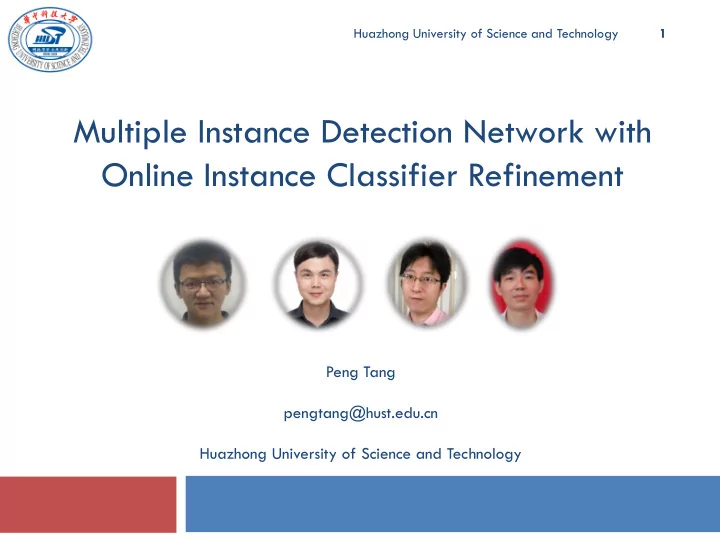

Huazhong University of Science and Technology 1 Multiple Instance Detection Network with Online Instance Classifier Refinement Peng Tang pengtang@hust.edu.cn Huazhong University of Science and Technology
Weakly-supervised visual learning (WSVL) 2 Weakly-supervised visual learning is a new trend in CVPR Search keyword “ weakly supervised ” (14 papers), “ weakly-supervised ” (5 papers), “ multi-instance ” (1 paper), and “ multiple instance ” (3 papers), 23/783 papers in total http://cvpr2017.thecvf.com/program/main_conference Huazhong University of Science and Technology
WSVL avoids the expensive human annotations 3 Tasks Training info Testing output Weakly-supervised Image-level Bounding box object detection (WSOD) Weakly-supervised Image-level Pixel-level sematic segmentation Weakly-supervised Image- Instance pixel-level instance segmentation level/bounding box Semi-supervised object Partial of fully- Bounding box/pixel- detection/segmentation labeled data level Huazhong University of Science and Technology
WSVL avoids the expensive human annotations 4 Tasks Training info Testing output Weakly-supervised Image-level Bounding box object detection (WSOD) Weakly-supervised Image-level Pixel-level sematic segmentation Weakly-supervised Image- Instance pixel-level instance segmentation level/bounding box Semi-supervised object Partial of fully- Bounding box/pixel- detection/segmentation labeled data level Huazhong University of Science and Technology
How to do WSOD 5 Huazhong University of Science and Technology
How to do WSOD 6 Possible solutions to this problem, clustering based, matching based, co-segmentation based, topic model based, multi-instance learning based method. Huazhong University of Science and Technology
How to do WSOD 7 Possible solutions to this problem, clustering based, matching based, co-segmentation based, topic model based, multi-instance learning based method. Solving this problem by multiple instance learning • Image as bag, since image label is given • Proposals (Selective Search, EdgeBox, Bing) as instances • Proposal descriptors: Deep CNN Features, Fisher Vectors • Number of proposals: ~2k (SS), ~4k (EB) Huazhong University of Science and Technology
What is the core problem in WSOD 8 Is it a bird ? The answers are YES! Huazhong University of Science and Technology
What is the core problem in WSOD 9 Is it a bird ? The answers are YES! However, only some of them are correct detection results (IoU>0.5) Huazhong University of Science and Technology
What is the core problem in WSOD 10 Is it a bird ? The answers are YES! However, only some of them are correct detection results (IoU>0.5) Huazhong University of Science and Technology
What is the core problem in WSOD 11 Is it a bird ? ambiguity The answers are YES! However, only some of them are correct detection results (IoU>0.5) Huazhong University of Science and Technology
What is the core problem in WSOD 12 Previous methods tend to localize parts of objects instead of whole objects. Result of MIDN/WSDDN [4] Huazhong University of Science and Technology
13 Multiple Instance Detection Network with Online Instance Classifier Refinement Huazhong University of Science and Technology
Motivation 14 Proposals having high spatial overlaps with detected parts may cover the whole object, or at least contain larger portion of the object. Result of MIDN/WSDDN [4] Huazhong University of Science and Technology
Motivation 15 Propagating the scores to the highly overlapped proposals to alleviate the problem cased by ambiguity Result of MIDN/WSDDN [4] Result of OICR Huazhong University of Science and Technology
The multi-instance detection network (MIDN) 16 Huazhong University of Science and Technology
The multi-instance detection network (MIDN) 17 The basic network of WSDDN [4] by H. Bilen and A. Vedaldi Single network, end to end training Huazhong University of Science and Technology
The multi-instance detection network (MIDN) 18 Huazhong University of Science and Technology
The multi-instance detection network (MIDN) 19 Huazhong University of Science and Technology
The network for OICR 20 Huazhong University of Science and Technology
The network for OICR 21 Additional blocks (instance classifiers) for score propagation In-network supervision Huazhong University of Science and Technology
Effective online training/refinement 22 Huazhong University of Science and Technology
Effective online training/refinement 23 The top scoring proposal can always detect at least parts of objects. Huazhong University of Science and Technology
Effective online training/refinement 24 The top scoring proposal can always detect at least parts of objects. Proposals having high spatial overlaps with detected parts may cover larger portion of the object. Huazhong University of Science and Technology
Effective online training/refinement 25 The top scoring proposal can always detect at least parts of objects. Proposals having high spatial overlaps with detected parts may cover larger portion of the object. Proposals with high spatial overlap could share similar label information. Huazhong University of Science and Technology
Effective online training/refinement 26 Huazhong University of Science and Technology
Effective online training/refinement 27 The loss weight controls the learning process. Huazhong University of Science and Technology
Experimental Results 28 Huazhong University of Science and Technology
Experimental Results 29 The influence of refinement times and different refinement strategies Huazhong University of Science and Technology
Experimental Results 30 Detection results (mAP) on VOC 2007 test set Detection results (mAP) on VOC 2012 test set Huazhong University of Science and Technology
Experim e ntal Results 31 Huazhong University of Science and Technology
Conclusion 32 Advantages Our method can improve the detection results a lot through our OICR strategy, especially for rigid objects. The network can be trained in a very efficiently (online) way. Huazhong University of Science and Technology
Conclusion 33 Advantages Our method can improve the detection results a lot through our OICR strategy, especially for rigid objects. The network can be trained in a very efficiently (online) way. Limitations The performance is poor for non-rigid objects, as these objects are always with great deformation and their representative parts are with much less deformation. Huazhong University of Science and Technology
Thank you! 34 Preprint is available at https://arxiv.org/abs/1704.00138. Codes are available at https://github.com/ppengtang/oicr. Huazhong University of Science and Technology
Recommend
More recommend